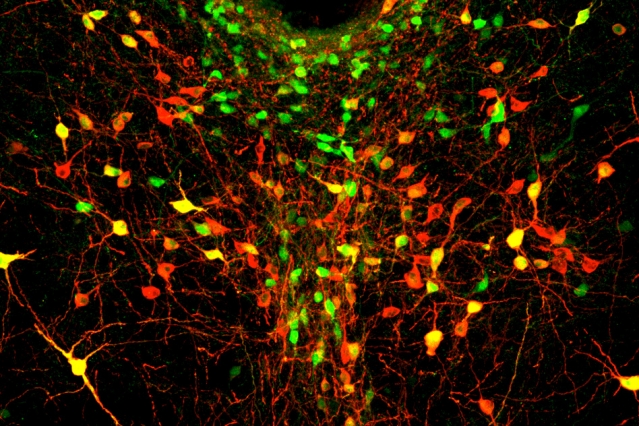
In this image of the dorsal raphe nucleus, dopamine neurons are labeled in green, red, or both (appearing yellow).
Image: Gillian Matthews
Pinpointing loneliness in the brain
Scientists identify cells that represent feelings of isolation.
Source [Anne Trafton | MIT News Office, February 11, 2016]
Humans, like all social animals, have a fundamental need for contact with others. This deeply ingrained instinct helps us to survive; it’s much easier to find food, shelter, and other necessities with a group than alone. Deprived of human contact, most people become lonely and emotionally distressed.
In a study appearing in the Feb. 11 issue of Cell, MIT neuroscientists have identified a brain region that represents these feelings of loneliness. This cluster of cells, located near the back of the brain in an area called the dorsal raphe nucleus (DRN), is necessary for generating the increased sociability that normally occurs after a period of social isolation, the researchers found in a study of mice.
“To our knowledge, this is the first time anyone has pinned down a loneliness-like state to a cellular substrate. Now we have a starting point for really starting to study this,” says Kay Tye, the Whitehead Career Development Assistant Professor of Brain and Cognitive Sciences, a member of MIT’s Picower Institute for Learning and Memory, and one of the senior authors of the study.
While much research has been done on how the brain seeks out and responds to rewarding social interactions, very little is known about how isolation and loneliness also motivate social behavior.
“There are many studies from human psychology describing how we have this need for social connection, which is particularly strong in people who feel lonely. But our understanding of the neural mechanisms underlying that state is pretty slim at the moment. It certainly seems like a useful, adaptive response, but we don’t really know how that’s brought about,” says Gillian Matthews, a postdoc at the Picower Institute and the paper’s lead author.
Only the lonely
Matthews first identified the loneliness neurons somewhat serendipitously, while studying a completely different topic. As a PhD student at Imperial College London, she was investigating how drugs affect the brain, particularly dopamine neurons. She originally planned to study how drug abuse influences the DRN, a brain region that had not been studied very much.

